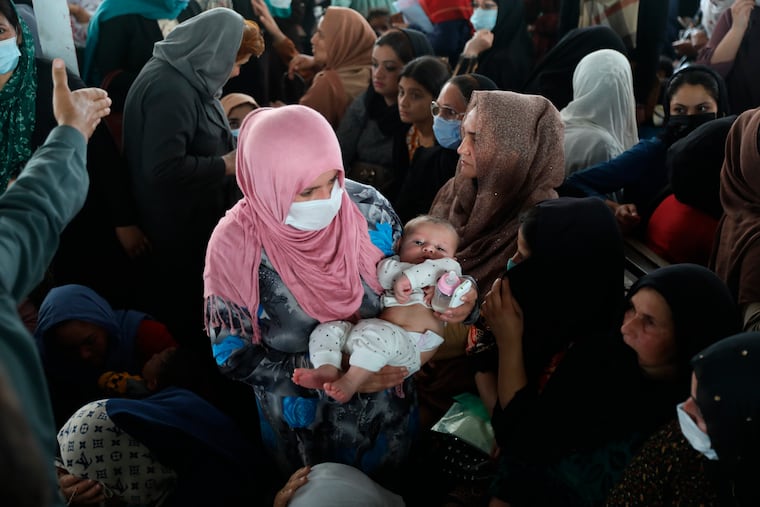The U.S. never prioritized Afghan women and girls | Opinion
But we can do better now by letting Afghans and civilian experts take the lead.

Afghanistan’s experiment with democracy has paused. The Taliban is back in power, and President Ashraf Ghani fled the country. Despite the Taliban’s claims that it will form an open and inclusive government, observers expect it to exclude women from decision-making roles.
When the U.S. invaded Afghanistan in 2001, the plight of Afghan girls and women drew a great deal of attention. The first lady, Laura Bush, condemned Taliban members’ oppression of women as evidence that they were terrorists and must be fought by “civilized people.” This week feels like a horrible rerun of those oversimplifications.
I am a Philadelphian who studies the intersection of religion, politics, and gender. Those of us in the field quickly spoke out against this use of Afghan women to justify war. While many of us had spent years trying to get some attention and sympathy for Afghan women, we rejected a military approach to “saving” them. It was clear that to claim sympathy for Afghan women while dropping bombs on their children and husbands made no sense. Instead, we argued that protecting the rights of Afghan women could only happen when the whole society was stable and secure.
» READ MORE: The horror of Afghan women abandoned by America’s troop pullout | Trudy Rubin
Why are Afghan women’s rights tied to overall security? Because research shows that the greater the insecurity and uncertainty faced by Afghan families, the more likely they are to keep their children home from school, marry their daughters off at puberty, and restrict women’s movements outside the home. When parents are afraid for their children, they protect them the best way they can. In a poor and rural society, that means restricting girls’ access to school and pushing them into marriages in the hope that they will gain some protection from their husbands.
In the years after the American invasion of Afghanistan, there were so many problems — including civilian casualties, corruption, the opium trade, and interethnic tensions. The one bright spot seemed to be the greater number of Afghan girls attending school. From less than a million children in school in 2000, by 2010 more than seven million boys and girls were in school. These numbers peaked in 2011 during the Obama “surge.” Since then fewer girls are attending school as the security situation deteriorated. The U.S. withdrawal will make it all much worse.
Yet, the suggestion that the U.S. has long sought to protect women falls a bit flat. Afghanistan regularly is at the top of the list of most dangerous places to be a girl and is at the bottom of gender equality measures — even in the years that the Taliban controlled less than 10% of the country. During the U.S. occupation itself, the priority for NATO forces was counterterrorism, not the well-being of Afghan girls or families.
» READ MORE: The local lesson from Afghanistan’s fall | Editorial
Most of the money funneled into Afghanistan (over $800 billion) was distributed by the U.S. military rather than by the civilian agencies that actually know how to do the work of “nation-building.” Provincial reconstruction units were given discretionary funds to spend on whatever local projects they decided mattered. The development agencies and nongovernmental organizations (NGOs) staffed with experts who know how to engage in inclusive, community-driven projects were marginalized. Sarah Chayes, author of Thieves of State: Why Corruption Threatens Global Security, spent years warning of the waste and corruption and how it fed into a mistrust of the Afghan government and strengthened the Taliban. But nothing changed in how the U.S. handled its mission.
The country is at a genuine turning point. About 60% of the people in Afghanistan are under the age of 25 and have no lived memory of life under the Taliban. Though it is disingenuous to say that girls and women were a top U.S. priority throughout the occupation, two decades of greater freedom and opportunity for women have shaped their realities. In the years after 2001, over five million Afghans returned to the country from Pakistan, Iran, and other places where they had sought shelter during the Taliban’s prior rule. Many of them may leave again, but they have changed Afghan society. There are flourishing television, radio, and newspaper producers. There are civil society activists and new politicians. There are women who have been professionals in the police, hospitals, colleges, etc., who are unlikely to simply accept their exclusion.
Today as Afghanistan returns to Taliban control, the international community probably won’t go back in with their militaries. Perhaps now finally the civilian experts — academics, local community leaders, and humanitarian workers — can take the lead. Because even if the U.S. military is no longer in Afghanistan, there are still 17 million Afghan women and girls — alongside the 17 million other Afghan citizens, including men and boys — who need continuing support. And we owe them that support. This time let’s listen to Afghan voices and priorities.
Nandini Deo is an associate professor of political science at Lehigh University.